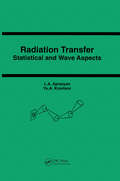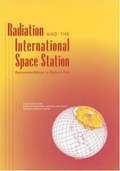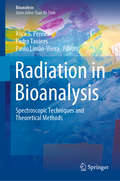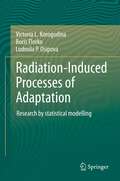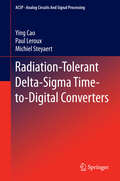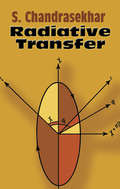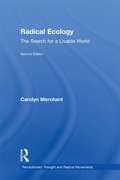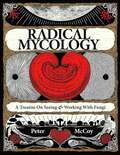- Table View
- List View
Radiation Transfer
by L. A. Apresyan Yu. A KravtsovThe authors expound on non-traditional phenomena for transfer theory, which are nevertheless of considerable interest in wave measurements, and bring the advances of transfer theory as close as possible to the practical needs of those working in all areas of wave physics. The book opens with a historical overview of the topic, then moves on to examine the phenomenological theory of radiative transport, blending traditional theory with original ideas. The transport equation is derived from first principles, and the ensuing discussion of the diffraction content of the transport equation and non-classical radiometry is illustrated by practical examples from various fields of physics. Popular techniques of solving the transport equation are discussed, paying particular attention to wave physics and computing the coherence function. The book also examines various problems which are no longer covered by the traditional radiative transfer theory, such as enhanced backscattering and weak localization phenomena, nonlinear transport problems and kinetic equations for waves. This monograph bridges the gap between the simple power balance description in radiative transfer theory and modern coherence theory. It will be of interest to researchers and professionals working across a wide range of fields from optics, acoustics and radar theory to astrophysics, radioastronomy and remote sensing, as well as to students in these areas.
Radiation and Health
by Thormod Henriksen David H. MaillieRadiation and the effects of radioactivity have been known for more than 100 years. International research spanning this period has yielded a great deal of information about radiation and its biological effects and this activity has resulted in the discovery of many applications in medicine and industry including cancer therapy, medical diagnostics
Radiation and Radioactivity on Earth and Beyond
by Jean-Pierre Adloff Ivan G. DraganicThis book features information regarding the Chernobyl nuclear accident, the production of elementary particles, radiation exposure, the geopolitical effects of the end of the nuclear arms race between the U.S. and the former Soviet Union, and the future of nuclear power.
Radiation and the International Space Station: Recommendations to Reduce Risk
by Committee on Solar Space PhysicsA risk report on Radiation and the International Space Station
Radiation in Bioanalysis: Spectroscopic Techniques and Theoretical Methods (Bioanalysis #8)
by Alice S. Pereira Pedro Tavares Paulo Limão-VieiraThis book describes the state of the art across the broad range of spectroscopic techniques used in the study of biological systems. It reviews some of the latest advances achieved in the application of these techniques in the analysis and characterization of small and large biological compounds, covering topics such as VUV/UV and UV-visible spectroscopies, fluorescence spectroscopy, IR and Raman techniques, dynamic light scattering (DLS), circular dichroism (CD/SR-CD), pulsed electron paramagnetic resonance techniques, Mössbauer spectroscopy, nuclear magnetic resonance, X-ray methods and electron and ion impact spectroscopies. The second part of the book focuses on modelling methods and illustrates how these tools have been used and integrated with other experimental and theoretical techniques including also electron transfer processes and fast kinetics methods. The book will benefit students, researchers and professionals working with these techniques to understand the fundamental mechanisms of biological systems.
Radiation in Space: Relevance and Risk for Human Missions (SpringerBriefs in Space Life Sciences)
by Thomas Berger Christine E. Hellweg Daniel Matthiä Christa Baumstark-KhanThis volume of the series Springer Briefs in Space Life Sciences explains the physics and biology of radiation in space, defines various forms of cosmic radiation and their dosimetry, and presents a range of exposure scenarios. It also discusses the effects of radiation on human health and describes the molecular mechanisms of heavy charged particles’ deleterious effects in the body. Lastly, it discusses countermeasures and addresses the vital question: Are we ready for launch? Written for researchers in the space life sciences and space biomedicine, and for master’s students in biology, physics, and medicine, the book will also benefit all non-experts endeavouring to understand and enter space.
Radiation, Ionization, and Detection in Nuclear Medicine
by Tapan K. GuptaThis book will serve as the definitive source of detailed information on radiation, ionization, and detection in nuclear medicine. It opens by considering fundamental aspects of nuclear radiation, including dose and energy, sources, and shielding. Subsequent chapters cover the full range of relevant topics, including the detection and measurement of radiation exposure (with detailed information on mathematical modelling); medical imaging; the different types of radiation detector and their working principles; basic principles of and experimental techniques for deposition of scintillating materials; device fabrication; the optical and electrical behaviors of radiation detectors; and the instrumentation used in nuclear medicine and its application. The book will be an invaluable source of information for academia, industry, practitioners, and researchers.
Radiation-Induced Processes of Adaptation: Research by statistical modelling
by Victoria L. Korogodina Ludmila P. Osipova Boris FlorkoIn recent decades radiobiologists' efforts have been directed at identifying the mechanisms of radiation effects; the general mechanisms have since been studied extensively. This book describes and analyzes radiation-induced adaptation as processes produced in cells, tissues, and populations. This viewpoint helps to understand the nature and factors of induced processes, to determine the characteristics of observed radiation effects and their limitations. The investigations presented here were founded on proper lab experiments, ecological studies of plant population growth near an operating nuclear power plant and a thorough epidemiological examination of human populations living in territories polluted fifty years ago, as well as on relevant published data. This research demonstrates the radiation-induced adaptation processes that continue even when the radiation itself is no longer at a critical background level. The investigations utilized the method of statistical modeling on the basis of distributions on the number of abnormalities. This method allows us to investigate the processes induced by low-dose factors when accompanied by Darwinian selection in different systems; the distribution parameters can then be used to study the characteristics of adaptation processes and system resistance. The consequences of background-level radiation continue to provoke debate, and the mathematical bases of the adaptation model are shown, while due consideration is paid to the components of adaptation: instability, selection, and proliferation. The book will be especially useful to specialists in radiation pollution, ecology, epidemiology, and radiology for studies of radiation-induced processes; the method presented here can also be adapted to investigate low-dose effects in other fields. In addition, the book presents a number of reviews in the fields of radiation biology, including pioneering investigations in Russia which were previously unavailable to Western scientists.
Radiation-Tolerant Delta-Sigma Time-to-Digital Converters
by Michiel Steyaert Ying Cao Paul LerouxThis book focuses on the design of a Mega-Gray (a standard unit of total ionizing radiation) radiation-tolerant ps-resolution time-to-digital converter (TDC) for a light detection and ranging (LIDAR) system used in a gamma-radiation environment. Several radiation-hardened-by-design (RHBD) techniques are demonstrated throughout the design of the TDC and other circuit techniques to improve the TDC's resolution in a harsh environment are also investigated. Readers can learn from scratch how to design a radiation-tolerant IC. Information regarding radiation effects, radiation-hardened design techniques and measurements are organized in such a way that readers can easily gain a thorough understanding of the topic. Readers will also learn the design theory behind the newly proposed delta-sigma TDC. Readers can quickly acquire knowledge about the design of radiation-hardened bandgap voltage references and low-jitter relaxation oscillators, which are introduced in the content from a designer's perspective. · Discusses important aspects of radiation-tolerant analog IC design, including realistic applications and radiation effects on ICs; · Demonstrates radiation-hardened-by-design techniques through a design-test-radiation assessment practice; · Describes a new type of Time-to-Digital (TDC) converter designed for radiation-tolerant application; · Explains the design and measurement of all functional blocks (e. g. , bandgap reference, relaxation oscillator) in the TDC.
Radiation: An Energy Carrier
by Tetsuo TanabeThis book aims to explain radiation from a somewhat different aspect than its traditional image as something that is scary, dangerous, hazardous, and so on, to produce the correct understanding that radiation is carrying energy, and to convince readers that radiation is not "scary" but controllable and useful. As for radiation itself, many introductions or textbooks have been published, as in radiochemistry, radiobiology, and radiology. In most of them, the biological effects of radiation exposure are the main subjects, which often enhance the feeling that radiation is dangerous, and the effects produced by lower-dose exposure that are difficult to see are hardly discussed. The present volume mainly focuses on how radiation carries energy, how energy is absorbed in substances as absorbed doses (Gy) or dose equivalents (Sv), how damages or risks appear with the absorbed dose and why the effects of the exposure appear quite differently, depending on properties of the substances that were exposed.
Radiation: What It Is, What You Need to Know
by Eric Lax Robert Peter GaleThe essential guide to radiation: the good, the bad, and the utterly fascinating, explained with unprecedented clarity. Earth, born in a nuclear explosion, is a radioactive planet; without radiation, life would not exist. And while radiation can be dangerous, it is also deeply misunderstood and often mistakenly feared. Now Robert Peter Gale, M.D,--the doctor to whom concerned governments turned in the wake of the Chernobyl and Fukushima disasters--in collaboration with medical writer Eric Lax draws on an exceptional depth of knowledge to correct myths and establish facts. Exploring what have become trigger words for anxiety--nuclear energy and nuclear weapons, uranium, plutonium, iodine-131, mammogram, X-ray, CT scan, threats to the food chain--the authors demystify the science and dangers of radiation, and examine its myriad benefits, from safely sterilizing our food to the relatively low-risk fuel alternative of nuclear energy. This is the book for all readers who have asked themselves questions such as: What kinds of radiation, and what degree of exposure, cause cancer? What aftereffects have nuclear accidents and bombs had? Does radiation increase the likelihood of birth defects? And how does radiation work? Hugely illuminating, Radiation is the definitive road map to our post-Chernobyl, post-Fukushima world.
Radiative Heat Transfer in Participating Media: With MATLAB Codes
by C. Balaji S. P. Venkateshan Rahul YadavThis book aims at providing a computational framework of radiative heat transfer in participating media. The book mainly helps engineers and researchers develop their own codes for radiative transfer analysis, starting from simple benchmark problems and extending further to industry scale problems. The computations related to radiative heat transfer are very relevant in iron and steel manufacturing industries, rocket exhaust designing, fire resistance testing, and atmospheric and solar applications. The methods to accurately treat the non-gray nature of the participating gases such as H2O, CO2, and CO are discussed along with considering particle radiation. The solver development based on these methods and its application to a variety of industry problems and different kind of geometries is a significant attraction in the book. The last section of the book deals with the use of artificial neural networks and genetic algorithm-based optimization technique for solving practical problems of process parameter optimization in industry. This book is a comprehensive package taking the readers from the basics of radiative heat transfer in participating media to equip them with their own solvers and help to apply to industry problems.
Radiative Heat Transfer in Turbulent Combustion Systems
by Michael F. Modest Daniel C. HaworthThis introduction reviews why combustion and radiation are important, as well as the technical challenges posed by radiation. Emphasis is on interactions among turbulence, chemistry and radiation (turbulence-chemistry-radiation interactions - TCRI) in Reynolds-averaged and large-eddy simulations. Subsequent chapters cover: chemically reacting turbulent flows; radiation properties, Reynolds transport equation (RTE) solution methods, and TCRI; radiation effects in laminar flames; TCRI in turbulent flames; and high-pressure combustion systems. This Brief presents integrated approach that includes radiation at the outset, rather than as an afterthought. It stands as the most recent developments in physical modeling, numerical algorithms, and applications collected in one monograph.
Radiative Processes In Astrophysics
by Alan P. Lightman George B. RybickiRadiative Processes in Astrophysics: This clear, straightforward, and fundamental introduction is designed to present-from a physicist's point of view-radiation processes and their applications to astrophysical phenomena and space science. It covers such topics as radiative transfer theory, relativistic covariance and kinematics, bremsstrahlung radiation, synchrotron radiation, Compton scattering, some plasma effects, and radiative transitions in atoms. Discussion begins with first principles, physically motivating and deriving all results rather than merely presenting finished formulae. However, a reasonably good physics background (introductory quantum mechanics, intermediate electromagnetic theory, special relativity, and some statistical mechanics) is required. Much of this prerequisite material is provided by brief reviews, making the book a self-contained reference for workers in the field as well as the ideal text for senior or first-year graduate students of astronomy, astrophysics, and related physics courses. Radiative Processes in Astrophysics also contains about 75 problems, with solutions, illustrating applications of the material and methods for calculating results. This important and integral section emphasizes physical intuition by presenting important results that are used throughout the main text; it is here that most of the practical astrophysical applications become apparent.
Radiative Processes in High Energy Astrophysics
by Gabriele GhiselliniThis book grew out of the author's notes from his course on Radiative Processes in High Energy Astrophysics. The course provides fundamental definitions of radiative processes and serves as a brief introduction to Bremsstrahlung and black body emission, relativistic beaming, synchrotron emission and absorption, Compton scattering, synchrotron self-compton emission, pair creation and emission. The final chapter discusses the observed features of Active Galactic Nuclei and their interpretation based on the radiative processes presented in the book. Written in an informal style, this book will guide students through their first encounter with high-energy astrophysics.
Radiative Transfer In The Atmosphere And Ocean
by Jakob J. Stamnes Knut Stamnes Gary E. ThomasThis new and completely updated edition gives a detailed description of radiative transfer processes at a level accessible to advanced students. The volume gives the reader a basic understanding of global warming and enhanced levels of harmful ultraviolet radiation caused by ozone depletion. It teaches the basic physics of absorption, scattering and emission processes in turbid media, such as the atmosphere and ocean, using simple semi-classical models. The radiative transfer equation, including multiple scattering, is formulated and solved for several prototype problems, using both simple approximate and accurate numerical methods. In addition, the reader has access to a powerful, state-of-the-art computational code for simulating radiative transfer processes in coupled atmosphere-water systems including snow and ice. This computational code can be regarded as a powerful educational aid, but also as a research tool that can be applied to solve a variety of research problems in environmental sciences. Teaches solutions for radiative transfer problems across a broad range of disciplines with a self-contained, systematic treatment. Offers a unique emphasis on formulation, judicial approximations and numerical solutions. Provides a unified treatment of radiative transfer in coupled atmosphere-water systems, filling the gap between descriptive texts and practical approaches.
Radiative Transfer in Stellar and Planetary Atmospheres (Canary Islands Winter School of Astrophysics #29)
by Lucio Crivellari Sergio Simón-Díaz Maria Jesús ArévaloRadiative transfer is essential for obtaining information from the spectra of astrophysical objects. This volume provides an overview of the physical and mathematical background of radiative transfer, and its applications to stellar and planetary atmospheres. It covers the phenomenology and physics of early-type and late-type stars, as well as ultra-cool dwarf stars and extrasolar planets. Importantly, it provides a bridge between classical radiative transfer and stellar atmosphere modelling and novel approaches, from both theoretical and computational standpoints. With new fields of application and a dramatic improvement in both observational and computational facilities, it also discusses the future outlook for the field. Chapters are written by eminent researchers from across the astronomical disciplines where radiative transfer is employed. Using the most recent observations, this is a go-to resource for graduate students and researchers in astrophysics.
Radiative Transfer: An Introduction to Exact and Asymptotic Methods
by Hélène FrischThis book discusses analytic and asymptotic methods relevant to radiative transfer in dilute media, such as stellar and planetary atmospheres. Several methods, providing exact expressions for the radiation field in a semi-infinite atmosphere, are described in detail and applied to unpolarized and polarized continuous spectra and spectral lines. Among these methods, the Wiener–Hopf method, introduced in 1931 for a stellar atmospheric problem, is used today in fields such as solid mechanics, diffraction theory, or mathematical finance. Asymptotic analyses are carried out on unpolarized and polarized radiative transfer equations and on a discrete time random walk. Applicable when photons undergo a large number of scatterings, they provide criteria to distinguish between large-scale diffusive and non-diffusive behaviors, typical scales of variation of the radiation field, such as the thermalization length, and specific descriptions for regions close and far from boundaries. Its well organized synthetic view of exact and asymptotic methods of radiative transfer makes this book a valuable resource for both graduate students and professional scientists in astrophysics and beyond.
Radiative Transfer: Radiative Transfer And Negative Ion Of Hydrogen (Dover Books on Physics)
by Subrahmanyan ChandrasekharThis book by a Nobel Laureate provides the foundation for analysis of stellar atmospheres, planetary illumination, and sky radiation. Radiation transfer has been investigated as a phenomenon of astrophysics, and it has attained wider interest because of similar problems in the theory of neutron diffusion. Suitable for students and professionals in physics, nuclear physics, astrophysics, and atmospheric studies.
Radical Ecology: The Search for a Livable World (2nd edition)
by Carolyn MerchantIn the first edition of Radical Ecology--the now classic examination major philosophical, ethical, scientific, and economic roots of environmental problems--Carolyn Merchant responded to the profound awareness of environmental crisis which prevailed in the closing decade of the twentieth century. In this provocative and readable study, Merchant examines the ways that radical ecologists can transform science and society in order to sustain life on this planet. Now in this second edition, Merchant continues to emphasize how laws, regulations and scientific research alone cannot reverse the spread of pollution or restore our dwindling resources. Merchant argues that in order to maintain a livable world, we must formulate new social, economic, scientific, and spiritual approaches that will fundamentally transform human relationships with nature. She analyzes the revolutionary ideas of visionary ecologists for a new economy, society, science, and religion, and examines their efforts to bring environmental problems to the attention of the public. This new edition features a new Introduction from the author, a thorough updating of chapters, and two entirely new chapters on recent global movements and globalization and the environment. It is a timely update that will give students everything they need to know on the most recent philosophical positions and social movements that characterize the radical ecology spectrum.
Radical Ecology: The Search for a Livable World (Revolutionary Thought and Radical Movements)
by Carolyn MerchantThis is a new edition of the classic examination of major philosophical, ethical, scientific and economic roots of environmental problems which examines the ways that radical ecologists can transform science and society in order to sustain life on this planet. It features a new Introduction from the author, a thorough updating of chapters, and two entirely new chapters on recent Global Movements and Globalization and the Environment.
Radical Evolution: The Promise and Peril of Enhancing Our Minds, Our Bodies - and What It Means to Be Human
by Joel GarreauBestselling author Joel Garreau, a reporter and editor for the Washington Post, shows us that we are at an inflection point in history. As you read this, we are engineering the next stage of human evolution. Through advances in genetic, robotic, information and nanotechnologies, we are altering our minds, our memories, our metabolisms, our personalities, our progeny-and perhaps our very souls. Taking us behind the scenes with today's foremost researchers and pioneers, Garreau reveals that the super powers of our comic-book heroes already exist, or are in development in hospitals, labs, and research facilities around the country -- from the revved up reflexes and speed of Spider-Man and Superman, to the enhanced mental acuity and memory capabilities of an advanced species. Over the next fifteen years, Garreau makes clear, these enhancements will become part of our everyday lives. Where will they lead us? To heaven -- where technology's promise to make us smarter, vanquish illness and extend our lives is the answer to our prayers? Or will they lead us, as some argue, to hell -- where unrestrained technology brings about the ultimate destruction of our entire species? With the help and insights of the gifted thinkers and scientists who are making what has previously been thought of as science fiction a reality, Garreau explores how these developments, in our lifetime, will affect everything from the way we date to the way we work, from how we think and act to how we fall in love. It is a book about what our world is becoming today, not fifty years out. As Garreau cautions, it is only by anticipating the future that we can hope to shape it.
Radical Human Ecology: Intercultural and Indigenous Approaches
by Rose Roberts<P>Human ecology - the study and practice of relationships between the natural and the social environment - has gained prominence as scholars seek more effectively to engage with pressing global concerns.<P> In the past seventy years most human ecology has skirted the fringes of geography, sociology and biology.<P> This volume pioneers radical new directions. In particular, it explores the power of indigenous and traditional peoples' epistemologies both to critique and to complement insights from modernity and postmodernity.<P> Aimed at an international readership, its contributors show that an inter-cultural and transdisciplinary approach is required.<P> The demands of our era require a scholarship of ontological depth: an approach that can not just debate issues, but also address questions of practice and meaning. <P>Organized into three sections - Head, Heart and Hand - this volume covers the following key research areas: Theories of Human Ecology Indigenous and Wisdom Traditions Eco-spiritual Epistemologies and Ontology Research practice in Human Ecology The researcher-researched relationship Research priorities for a holistic world With the study of human ecology becoming increasingly imperative, this comprehensive volume will be a valuable addition for classroom use.
Radical Islam in East Africa
by Angel RabasaAmerican geopolitical interests and the potential threats to those interests are both on the rise in East Africa. The author places the spread of militant Islamism and the development of radical Islamist networks in East Africa in the broader context of the social, economic, and political factors that have shaped the region's security environment.
Radical Mycology: A Treatise on Seeing & Working With Fungi
by Peter McCoyInterwoven with short essays on the lessons of the fungi, Radical Mycology begins with chapters that explore the uniqueness of fungal biology, the critical ecological roles of micro and macro fungi, skills for accurately identifying mushrooms and mycorrhizal fungi, the importance of lichens as indicators of environmental health, and the profound influences that fungi have held on the evolution of all life and human cultures. With this foundation laid, the reader is then equipped to work with the fungi directly. Techniques for making potent fungal medicines, growing fermenting fungi for food, and cheaply cultivating mushrooms using recycled tools (and yet still achieving lab-quality results) are explored in-depth. Subsequent chapters grow far beyond the limits of other books on mushrooms. Detailed information on the principles and practices of what McCoy calls "regenerative natural mushroom farming"—a practice largely influenced by the design system of permaculture—is presented along with extensive information on cultivating mycorrhizal fungi and the science of mycoremediation, the application of fungi to mitigate pollution in our homes and environment. Concluding the book are deeper insights into the cultural effects that fungi present, from a philosophical reflection of fungal growth in the design of human societies, to an exhaustive examination of the history of psychoactive mushrooms.
